Contents

ALSO BY A. R. AMMONS
Bosh and FlapdoodleExpressions of Sea LevelCorsons InletTape for the Turn of the YearNorthfield PoemsSelected PoemsUplandsBriefingsCollected Poems: 19511971 (Winner of the National Book Award for Poetry, 1973)
Sphere: The Form of Motion (Winner of the 19731974 Bollingen Prize in Poetry)
DiversificationsThe Snow PoemsHighgate Road ALSO BY A. R. AMMONS
The Selected Poems: 19511977Selected Longer PoemsCoast of Trees (Winner of the National Book Critics
Circle Award for Poetry, 1981)
Worldly HopesLake Effect CountryThe Selected Poems: Expanded EditionSumerian VistasThe Really Short PoemsGarbage (Winner of the National Book Award for Poetry, 1993)
Brink RoadGlare OMMATEUM
with Doxology Poems A. AMMONS W. W. W.
Norton & Company New York London Copyright 1955 by A. R. Ammons. Copyright renewed 1983 by A. R.Ammons.
Preface copyright 2006 by W. W.
Norton & Company, Inc. All rights reserved For information about permission to reproduce selections from this book,
write to Permissions, W. W. Norton & Company, Inc., 500 Fifth Avenue,
New York, NY 10110 Production manager: Anna Oler The Library of Congress has cataloged the printed edition as follows: Ammons, A. R., 19262001.
Ommateum : with doxology : poems / A. R.
Ammons.
p. cm. ISBN 978-0-393-33054-0 I. Title.
PS3501.M606 2006
811'.54dc222006021695 ISBN (ebook) 978-1-324-00372-4 W. W. 10110
www.wwnorton.com W. W. W.
Norton & Company Ltd.
Castle House, 75/76 Wells Street, London W1T 3QT To Josephine Miles PREFACE In the spring of 1955 a small book of poems appeared bearing the imprint of Dorrance and Company, a Philadelphia vanity press. The title of the book was Ommateum, with Doxologytwo obscure Latinate words yoked by a preposition, the first a scientific name for the compound eye of an insect, the second a liturgical term for a hymn of praise. The books author, A. R. Ammons, was a twenty-nine-year-old navy veteran, a graduate of Wake Forest College with a degree in science, and a former masters student in English literature at UC Berkeley. At the time he was employed as a sales executive for his father-in-laws medical glassware business in southern New Jersey.
Ammons paid Dorrance $480 to print and distribute his book. Of three hundred sets of pages, only one hundred were bound; of those, only sixteen were sold in the five years after the books publication. Other copies were given away as gifts, many by the poets father-in-law to customers and business associates in South America. Ammons later claimed that his royalties on the book consisted of four four-cent stamps (a slight understatement). Today a first edition of Ommateum, with Doxology can fetch $3,000 on the rare book market. Ommateum, with Doxology may well be the most important self-published book of American poetry since Walt Whitman brought out the first edition of Leaves of Grass exactly one hundred years earlier.
As a debut volume it deserves a place alongside T. S. Eliots Prufrock and Other Observations, Wallace Stevenss Harmonium, Hart Cranes White Buildings, Gwendolyn Brookss A Street in Bronzeville, Elizabeth Bishops North and South, and John Ashberys Some Trees. Like those books, Ommateum is not apprentice work but the first expression of a mature, startlingly original artist, and a direct prophesy of the great career to come. Ammons himself held it in high esteem; in a 1989 interview he said, Ommateum remains a powerful influence with meadding, It may be my best book. As its title implies, the book falls into two sections: Ommateum, a sequence of thirty untitled poems, and the three-part Doxology, which is quite different in style and tone. The Ommateum poems are mostly stark first-person narratives that feature a mysterious protagonist named Ezra.
In a letter to Josephine Miles, Ammons explained that he took the name from a childhood friend who he believed had been killed in the war, adding I think of the character as wiry, evaporated, leathern, a desert creature, much soul and bone, little flesh. Ezra moves freely through time and space, witnessing miracles and atrocities, encountering gods, beasts, and elemental powers, repeatedly enacting his own death. The poems settings range from ancient Sumer and medieval Europe to places drawn from Ammonss own life, including the North Carolina farm where he grew up (The Sap Is Gone Out of the Trees, I Broke a Sheaf of Light), the coastal island of Hatteras where he spent a year as a school principal (So I Said I Am Ezra, The Whaleboat Struck), and the American Southwest, which he liked to say became his spiritual home instantly when he drove through it en route to California. In several poems the latter merges with the deserts of the Middle East, producing a surreal layering of American and biblical landscapes. In his unsigned foreword (originally written as jacket copy and then moved inside the book), Ammons describes the poems style as terse and evocative, adding that they suggest and imply and rather grow in the readers mind than exhaust themselves in completed, external form. With the exception of Doxology, the poems eschew punctuation entirely (Ammonss trademark colon is nowhere to be found), instead using lineation and spacing to map out syntax and indicate pauses.
Their fierce energy stems largely from their strong verbs; these include violent words like whip, strike, whirl, break, and lash, along with more neutral terms like come and turn that, as gerunds (coming, turning), often mark transitions from one scene to another. Nouns are generally basic, though we get a few flashes of the scientific diction that will become a major feature of Ammonss later work. A formal, supplicatory tone is evoked by the frequent use of the exclamations O and oh, carefully distinguished on the basis of their grammatical and rhetorical function. A central drama in Ommateum involves the speakers ongoing confrontation with the wind. The books famous opening poem begins So I said I am Ezra and the wind whipped my throat gaming for the sounds of my voice From the outset the wind threatens to rob the speaker of his voice and his identity. A far cry from Wordsworths correspondent breeze or even Shelleys wild west wind, this malevolent gale finds its own voice in the books second poem: The wind whipped at my carcass saying How shall I coming from these fields water the fields of earth and I said Oh and fell down in the dust Ammonss speaker will eventually learn to talk back to the wind; here he can only manage a single gasp before collapsing.
As the book proceeds, its winds grow less openly hostile, at one point becoming colossal promenaders: This land where whirlwinds walking at noon in tall columns of dust take stately turns about the desert is a very dry land The shift from whipping to whirling opens the way for another transformation, in which the wind becomes an agent of salvation rather than destruction: In the wind my rescue is in whorls of it like winged tufts of dreams bearing through the forms of nothingness the gyres and hurricane eyes the seed safety of multiple origins This poem, the books twenty-sixth, marks a crucial shift in Ezras relationship to the wind and the natural forces it represents. As the word bearing subtly suggests, the wind has assumed an almost maternal guise, protecting the speaker from the dangers of monolithic thought symbolized by the huge cairn of stones he resolves to build (I set it my task / to gather the stones of earth / into one place). Ezras praise of the winds eradicating power initiates what will become a central theme of Ammonss work, namely the (mixed) blessings of transience. The poets choice of the wind as a major embodiment of this theme can be traced back to childhood memory. In a 1989 interview Ammons recalled: It was when my little brother, who was two and a half years younger than I, died at eighteen months. My mother some days later found his footprint in the yard and tried to build something over it to keep the wind from blowing it away.

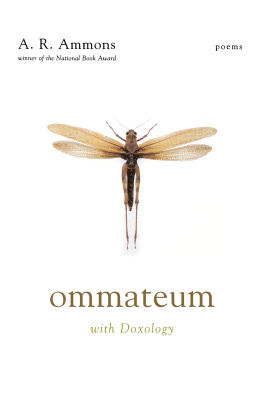

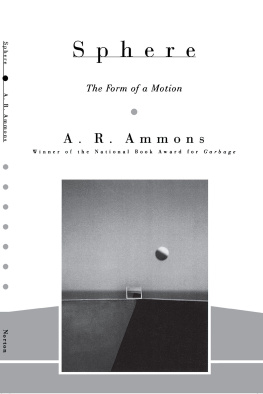
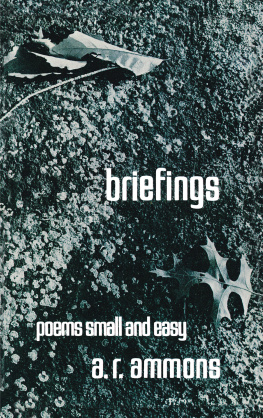
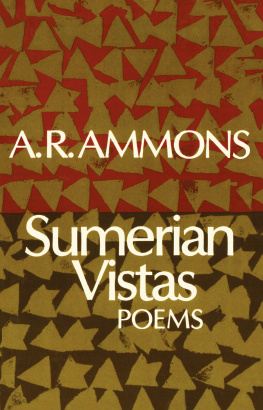


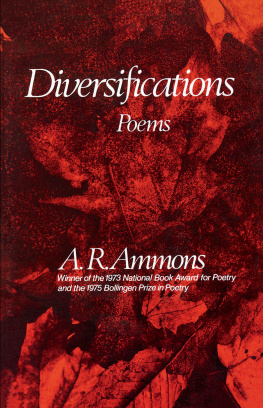

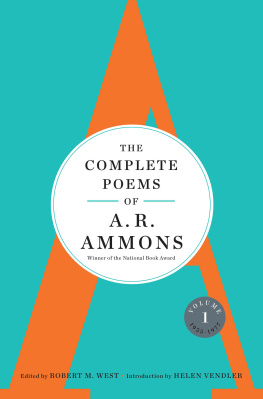
 ALSO BY A. R. AMMONS Bosh and FlapdoodleExpressions of Sea LevelCorsons InletTape for the Turn of the YearNorthfield PoemsSelected PoemsUplandsBriefingsCollected Poems: 19511971 (Winner of the National Book Award for Poetry, 1973) Sphere: The Form of Motion (Winner of the 19731974 Bollingen Prize in Poetry) DiversificationsThe Snow PoemsHighgate Road ALSO BY A. R. AMMONS The Selected Poems: 19511977Selected Longer PoemsCoast of Trees (Winner of the National Book Critics
ALSO BY A. R. AMMONS Bosh and FlapdoodleExpressions of Sea LevelCorsons InletTape for the Turn of the YearNorthfield PoemsSelected PoemsUplandsBriefingsCollected Poems: 19511971 (Winner of the National Book Award for Poetry, 1973) Sphere: The Form of Motion (Winner of the 19731974 Bollingen Prize in Poetry) DiversificationsThe Snow PoemsHighgate Road ALSO BY A. R. AMMONS The Selected Poems: 19511977Selected Longer PoemsCoast of Trees (Winner of the National Book Critics